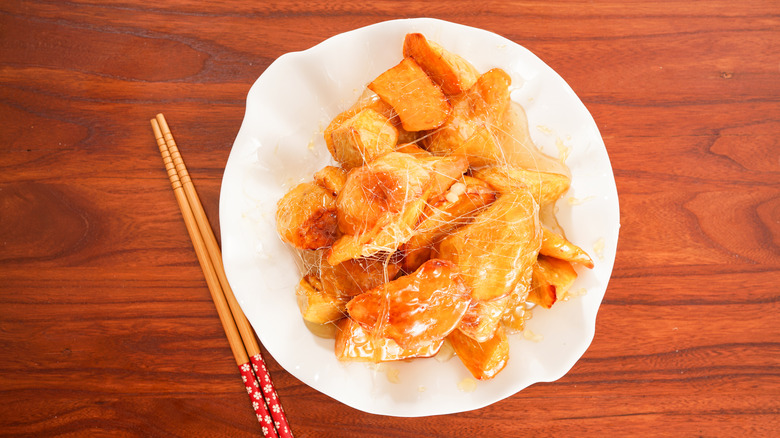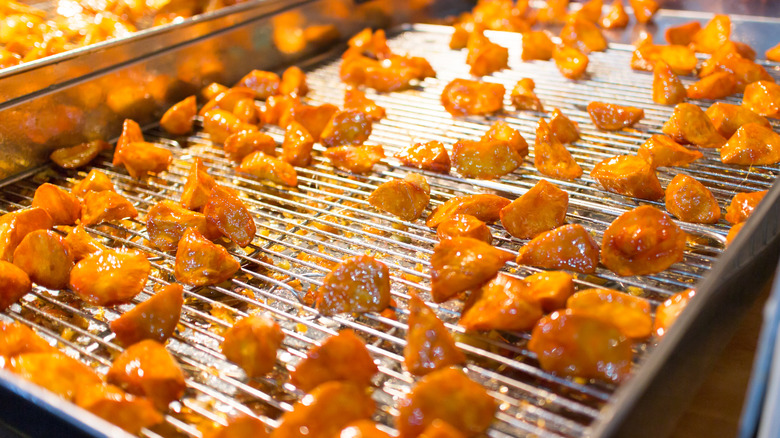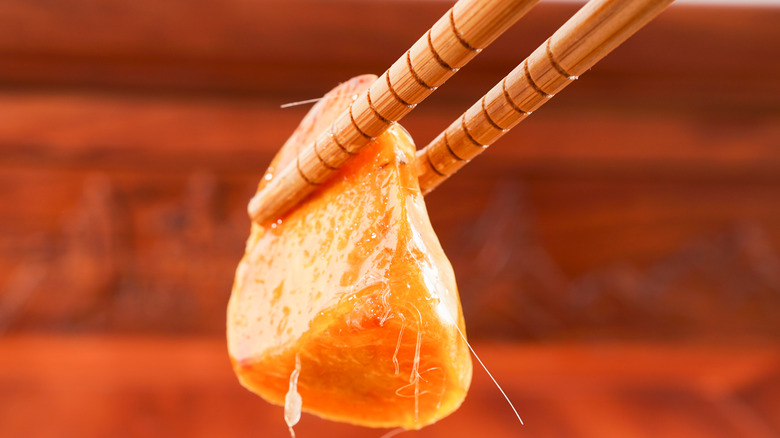Basi Digua: The Sweet Potatoes So Hot They're Served With Ice Water
How many Chinese desserts can you name off the top of your head? Perhaps a lightly sweet and crunchy fortune cookie comes to mind, though these were actually invented in California (via Fancy Fortune Cookies). Or, maybe grass jelly, egg tarts, or red bean buns (via China Highlights) are some of your favorites, since these aren't as sweet as most American desserts, per Insider. But if you know a thing or two about the cuisine in Northeastern China, then you've likely heard of basi digua.
Basi digua kind of looks like croquembouche on a plate, but with sweet potatoes instead of cream puffs. Threads of glistening sugar weave throughout each fried piece of candied sweet potato, highlighting light crispiness on the outside and creamy textures on the inside, according to Instagram user thingslinadoes. As YouTube personality Strictly Dumpling explains, the "ba" in "basi" means "pull" and the "si" term means "strands." So the translation becomes "pull-strand" (or "pull-silk") sweet potatoes, per Atlas Obscura.
When you pick up one of these sweet potatoes, the sugar strands "pull" away from it (via this separate thingslinadoes source), which creates an effect similar to cheesy dishes like mozzarella sticks or cheese pizza, as mentioned by Strictly Dumpling. The aesthetically-pleasing dessert also comes with a bowl of ice water — but more on that later.
How is basi digua made?
The ingredient list for basi digua is quite minimal. Aside from the ice water on the side, thingslinadoes explains that all you need are sweet potatoes, salt, sugar, and vegetable oil. Equipment-wise, it's good to have a wok, a Chinese spider strainer, a thermometer, and a tray with a wire rack over it (or a plate with some paper towels on it).
The cooking process itself is pretty straightforward. All you have to do is chop some peeled sweet potatoes into small pieces, fry them in hot oil (that is, "a bit past 350 Fahrenheit") for up to five minutes, then take them out to cool. (Note: lower the heat to medium after you add in the sweet potatoes.) The sweet potatoes are done when there's a crust on their exterior and when they can be pierced by a fork "with relatively little resistance."
For the sugar syrup, vegetable oil and sugar are added to a wok or pot. (Strictly Dumpling notes that you can skip the oil and just add the sugar straight to the wok/pot. Then, you can slowly pour in small amounts of water.) The outer rim of the sugar should slowly start to melt over medium heat, which should then be stirred over low heat. Add some salt and keep stirring until the sugar turns into an amber color and has melted completely. Mix in the sweet potatoes and then serve them on a plate.
Pitfalls when making basi digua
As previously mentioned, the ingredient list is minimal and the cooking process is straightforward. However, Week in China categorizes basi digua as one of the more difficult desserts to master. For starters, the sweet potatoes can either end up undercooked (too tough on the inside) or overcooked (way too soft on the inside). But the real test seems to lie within the sugar syrup.
As the source explains, a runny sauce won't transform into the glistening sugar strands that basi digua is known for. On the other hand, caramelizing it too much may result in bitter flavors and stickiness. But even the best sugar syrups cannot replace poor time management skills in the kitchen. Here's why: if those fried sweet potatoes aren't coated in the sugar syrup quickly, then they may become soggy — which may ruin this dessert entirely.
If that's still not enough, you'll need to consume basi digua quickly because the sugar will become hard instead of silky, which may affect the "pull" factor, per thingslinadoes. Atlas Obscura piggybacks on this by noting that the sweet potatoes can also "solidify" if they sit out too long, which is akin to biting into small rocks. (Don't worry though, that's where the bowl of ice water comes in handy).
How to eat basi digua
Once you've managed to perfect the intricacies of basi digua (or if you've managed the art of ordering this at a restaurant), simply take some chopsticks, grab a piece of candied sweet potato, and pull it away from its family. Marvel in the long sugary strings, but not for too long, because that sweet potato piece needs to be dunked into a bowl of ice water, per Strictly Dumpling.
If you skip this step and eat the sweet potato as is, you'll most likely burn your mouth. As Atlas Obscura explains, the potato and the sugar are very hot and the ice water helps to cool them down to a consumable temperature. The second benefit of this involves the hardening of the outside of the sweet potato. Strictly Dumpling calls this an "awesome crunchy outer shell" which aids in the textural contrast aspect of basi digua.
So all of this aside, how does it taste? There is, of course, that crunch from the outside mixed with the tenderness of the inside, which is enhanced by the sweetness of the sugar and sweet potato combination (which pair quite well together). One might expect much more complexity because of the stunning presentation, but each bite is actually quite simple, sweet, and humble, which, at the end of the day, are what "pull-silk" sweet potatoes are all about.



